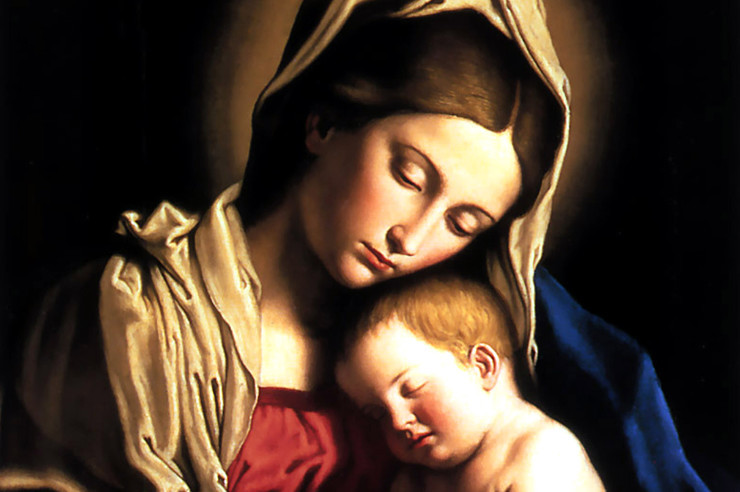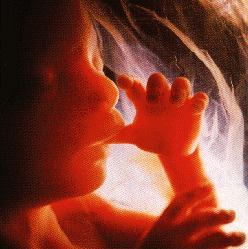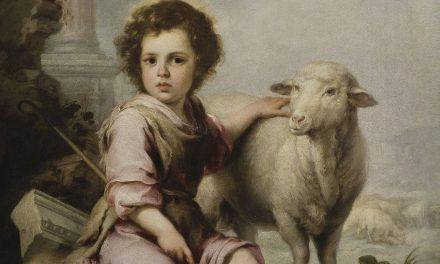Image: “Madonna and Child” (detail) by Sassoferrato | Restored Traditions
“Jesus, Who is God, is the only natural-born son who chose His mother. He had a plan for her life and she accepted it with her fiat, her yes given to the Archangel Gabriel at the Annunciation. For that we are eternally grateful and indebted to Mary, who was given to us to be our mother by her Son from the Cross.“
Each January 1 (the Octave of Christmas), the Church celebrates the Solemnity of Mary, Mother of God.
I receive more comments and questions from non-Catholics, and even some Catholics, about the Church’s Marian practices and teachings than just about any other topic. Some want to know where we can find these teachings in the bible. Some even suggest that Catholics pay too much attention to Mary, somehow leaving too little attention for Jesus.
I have written previously about how the Church’s dogmas concerning Mary are intended to teach us more about her Son than they are about Mary.
“Each of these teachings [the four Marian dogmas] reveals more about her Son than they do about Mary. They are Christ-centered (Christocentric) teachings. In other words, as the late Archbishop Sheen would say, we don’t start with Mary, but with her Son. Jesus we adore and worship, Mary, we venerate because of who her son is and the example of faith she lived and what learning about her can teach us about her Son.”
This is not to say our attention or devotion to the Blessed Mother should be diminished—it shouldn’t be—but the point is to understand the motivation of the Church to formalize these teachings which are a part of the Deposit of Faith.
So, let’s see what we can learn about Jesus through learning about Mary in the first of the four Marian Dogmas.
YES, MARY IS THE MOTHER OF GOD
Definition of the Dogma: The Catechism of the Catholic Church (CCC) ¶ 495 states, “Called in the Gospels ‘the mother of Jesus’, Mary is acclaimed by Elizabeth, at the prompting of the Spirit and even before the birth of her son, as ‘the mother of my Lord.’ [Lk 1:43; Jn 2:1; 19:25; cf. Mt 13:55; et al.] In fact, the One whom she conceived as man by the Holy Spirit, who truly became her Son according to the flesh, was none other than the Father’s eternal Son, the second person of the Holy Trinity. Hence the Church confesses that Mary is truly ‘Mother of God’ (Theotokos).” [cf Council of Ephesus (431): DS 251.]
You can probably see already in this short paragraph from the Catechism that this teaching about Mary contains important truths about her Son. See if you can spot them.
CHRISTOLOGICAL HERESIES
From the beginning, the Church had to counter erroneous teachings—or heresies—concerning Jesus Christ. These Christological Heresies were generally centered on the person and nature of Jesus—questions concerning who and what Jesus is.
- Is Jesus truly human?
- Is Jesus truly Divine?
- Is Jesus both truly and fully human and Divine?
These three questions led to other questions, such as, “If Jesus is both God and man, how many persons and natures, modes of operation and wills does He possess? How are they joined? When were they joined? Will they always be joined? Was His humanity really free? Was it real or just nothing more than a set of clothing worn by the Divine?”
These were the areas of Christology that the Church had to provide answers against the Christological Heresies. Some of these errors had already surfaced in Apostolic times, “Many deceivers have gone out into the world, those who do not acknowledge Jesus Christ as coming in the flesh; such is the deceitful one and the antichrist” (2 John 1:7).
Although it is much more invovled, let’s summarize three of these categories of errors:
- Denial of Christ’s Humanity – Some taught that the Christ was not human at all, that he had only an apparent body or that the body he wore came from heaven and not from Mary (mankind). Others denied that He possesed a human soul.
- Denial of Christ’s Divinity – Some rejected the teaching of the Church that Jesus was truly God or reduced Him to either an apparition of God or an enlightened mediator somewhere between God and man.
- Denial that Christ is One Person – Others accepted in some fashion that Jesus is both God and man, but denied these two natures were united in a single person.
One of these heresies that denied the Divinity of Christ was Arianism and its effect was far-reaching in both number of adherents and in years (a span of three centuries). Another heresy, Nestorianism, effectively, if not explicitly, divided Christ into two persons, one human and one divine. Mary had long been proclaimed by the faithful as Theotokos, God-bearer or Mother of God. Nestorius erroneously taught that while Mary was certainly the mother of the man (Jesus), she could not be the mother of the Logos (God).
The Apostle’s Creed states, in part, “I believe in God, the Father Almighty, Creator of heaven and earth; and in Jesus Christ, His only Son, our Lord: Who was conceived by the Holy Spirit, born of the Virgin Mary.” The prologue of John’s Gospel states, in part, “In the beginning was the Word, and the Word was with God, and the Word was God.”
There is only one Son, the eternal Logos—the Second Person of the Blessed Trinity—in Whom are two natures, one Divine and one human. He was conceived (His Incarnation) and born in time and of Mary who is His mother, for mothers are mothers of persons, not mothers of natures. So the Council of Ephesus, in A.D. 431, condemned the teaching of Nestorius with these words: “If anyone does not confess that the Emmanuel in truth is God and on this account the Holy Virgin is is the Mother of God—since according to the flesh she brought forth the Word of God made flesh—let him be anathema” [Fundamentals of Catholic Dogma; Dr. Ludwig Ott; Book III, Part III, Chapter 1].
Although the Council of Ephesus (Third Eccumenical Council of the Church) was called to deal with Nestorianism, it really addressed several truths that were denied in other heresies:
- Mary was truly a mother.
- Her son was one person.
- She bore the Logos, the Second Person of the Blessed Trinity, according to His humanity.
- The person she conceived and gave birth to was fully God and fully man.
TESTIMONY OF SCRIPTURE AND THE CHURCH FATHERS
These teachings are found in Sacred Scripture. The New Testament writers acknowledge that Mary was the mother of Jesus. They speak of His relation to Mary (Luke 2:4-7) and show Him to be a man (Luke 24:39). They declare Him to be God (John 1:1-4; Romans 9:1-5).
“For our God, Jesus Christ, was conceived by Mary in accord with God’s plan: of the seed of David, it is true, but also of the Holy Spirit” – [Saint Ignatius of Antioch; Bishop of Antioch; † ca. A. D. 110; Letter to the Ephesians; Jurgens I, § 42].
“The Word Himself, born of Mary who was still a Virgin, rightly received in birth the recapitulation of Adam, thereby recapitulating Adam Himself.” – [Saint Irenaeus; Bishop of Lyons; ca. A. D. 140 – ca. A. D. 202; Against Heresies; Jurgens I § 223]
“The Virgin Mary … being obedient to His Word, received from an angel the glad tidings that she would bear God.” – [Saint Irenaeus; Bishop of Lyons; ca. A. D. 140 – ca. A. D. 202; Against Heresies; Jurgens I § 256a]
“If anyone does not agree that Holy Mary is the Mother of God, he is at odds with the Godhead. If anyone asserts that Christ passed through the Virgin as through a channel, and was not shaped in her both divinely and humanly, divinely because without man and humanly because in accord with the law of gestation, he is likewise godless. If anyone assert that His manhood was formed, to be clothed over afterwards with divinity, he too is condemned; for this were not a generation of God, but a flight from generation . . . But He is not two Persons! Far be it! . . .” – [Saint Gregory of Nazianz; 2nd of the Great Cappadocian Fathers; Bishop of Sasima; ca. A. D. 330 – ca. A. D. 389; Letter to Cledonius, Against Apollinaris, A. D. 382; Jurgens I § 1017]
“We confess therefore that our Lord Jesus Christ is the Only-begotten Son of God, perfect God and perfect Man, having a rational soul and a body; according to His divinity, born of the Father before the ages, and in these last days, according to His humanity, born of the Virgin Mary for us and for our salvation. According to His divinity He is consubstantial with the Father, and according to His humanity He is consubstantial with us. A union was made of the two natures, on which account we confess one Christ, one Son, one Lord. In accord with this understanding of the unconfused union we confess that the Holy Virgin is the Mother of God, through God the Word’s being incarnate and becoming Man, and, from this conception, His joining to Himself the temple assumed from her . . .” – [Saint Cyril, Patriarch and Bishop of Alexandria, † A. D. 444; Letter to John, Bishop of Antioch; A. D. 433; Creed of Union or Creed of Ephesus; Jurgens III § 2060]
“The Word, then, was God, and He became also Man; and since He was born according to the flesh for the sake of mankind, it is necessary that she who bore Him is the Mother of God. For if she did not bear God, neither is He that was born of her to be called God. If the divinely inspired Scriptures name Him God, as God having been made Man and incarnate, He could not become Man in any other way than through birth from a woman: how then should she who bore Him not be the Mother of God?” – [Saint Cyril, Patriarch and Bishop of Alexandria, † A. D. 444; from Scholia on the Incarnation . . . ; A. D. 431, post-Council of Ephesus; Jurgens III § 2125]
JESUS IS TRUE GOD AND TRUE MAN
Jesus is true God and true man. He is one, single Divine Person, the Second Person of the Blessed Trinity in Whom, by His Incarnation, are two natures, one Divine (spirit) and one human (body and soul). All Christians today accept this truth formalized and proclaimed as de fide Dogmas of the Catholic Church. Mary, a true mother, was and is the Mother of that one, single Divine Person and is thus to be acknowledged as the Mother of God. This teaching was proclaimed to insure that the Dogmas concerning the identity and nature of Christ are clearly understood.
When friends, neighbors, family or acquaintances object that Catholics deify Mary by this teaching, you can now explain the reason and reasonableness of the title. No, Mary does not pre-date God, she is His creature. But she does pre-date God’s Incarnation in Jesus Christ. And since Jesus is not two people, but one Divine Person, she is rightly referred to as the mother of that person—The Mother of God.
GOD CHOSE MARY TO BECOME HIS MOTHER.
Reflect on this. Jesus, Who is God, is the only natural-born son who chose His mother. He had a plan for her life and she accepted it with her fiat, her yes given to the Archangel Gabriel at the Annunciation. For that we are eternally grateful and indebted to Mary, who was given to us to be our mother by her Son from the Cross.
And if anyone ever suggests to you that you love Mary too much, answer, “Oh no, I could not possibly love Mary too much, because I could never love her as much as she is loved by her son!”
Into the deep…
The readings for Christmastide—The Solemnity of Mary, Mother of God (Year ABC) are: Numbers 6:22-27; Psalms 67:2-3, 5, 6, 8; Galatians 4:4-7; Luke 2:16-21.














